Animal NDC 17030-103-01 Imoxi For Dogs
Imidacloprid And Moxidectin
Animal Product Information
Imoxi For Dogs Images
-
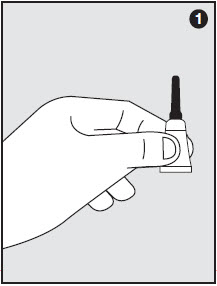
Figure 1 - imoxi 01
-
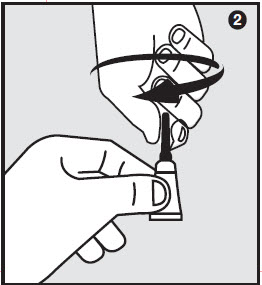
Figure 2 - imoxi 02
-
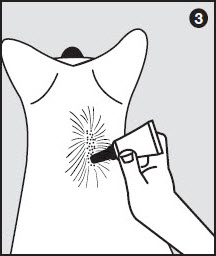
Figure 3 - imoxi 03
-
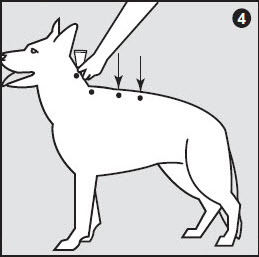
Figure 4 - imoxi 04
-
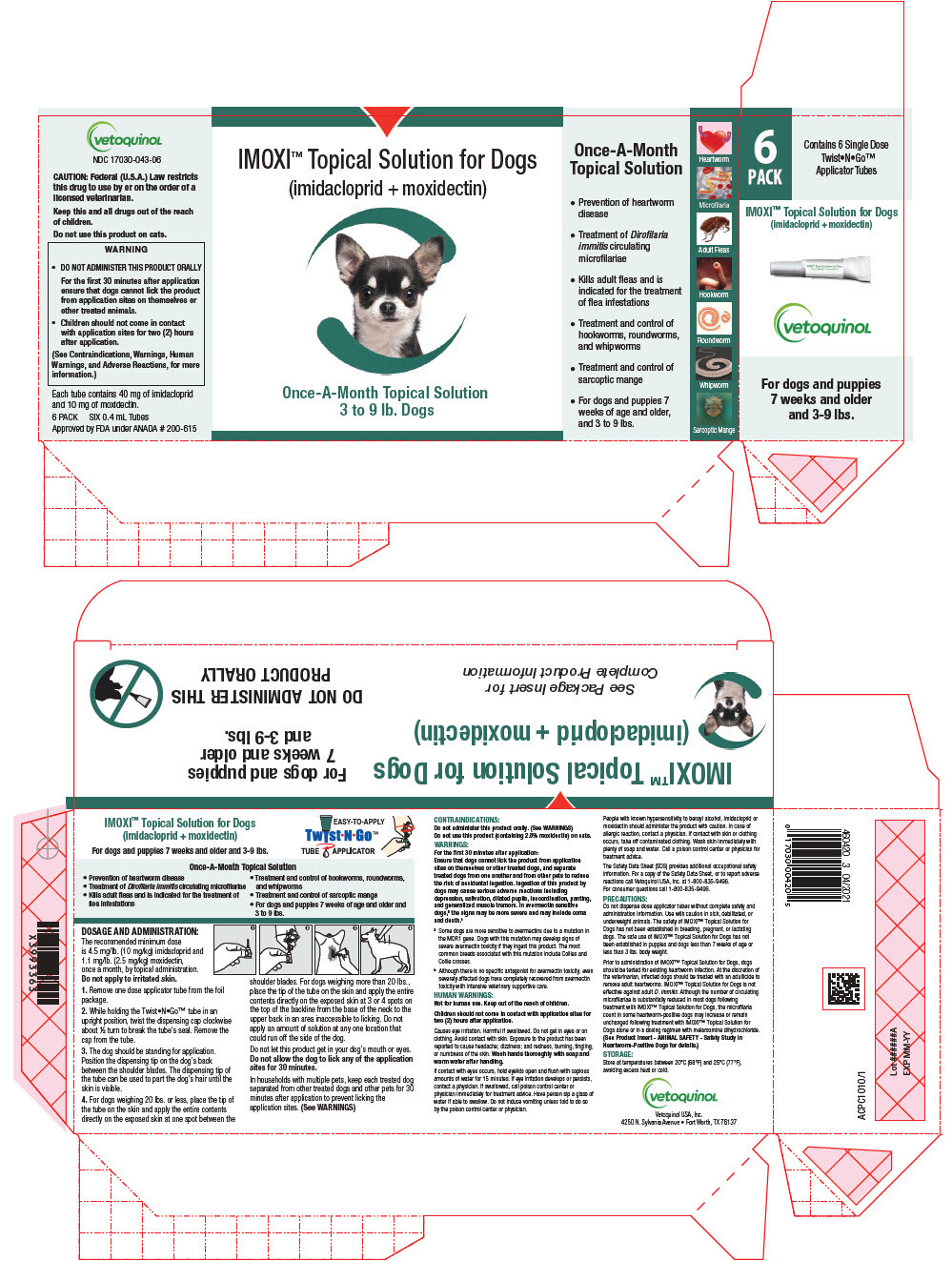
PRINCIPAL DISPLAY PANEL - 0.4 mL Tube Blister Pack Carton - imoxi 05
-

PRINCIPAL DISPLAY PANEL - 1.0 mL Tube Blister Pack Carton - imoxi 06
-
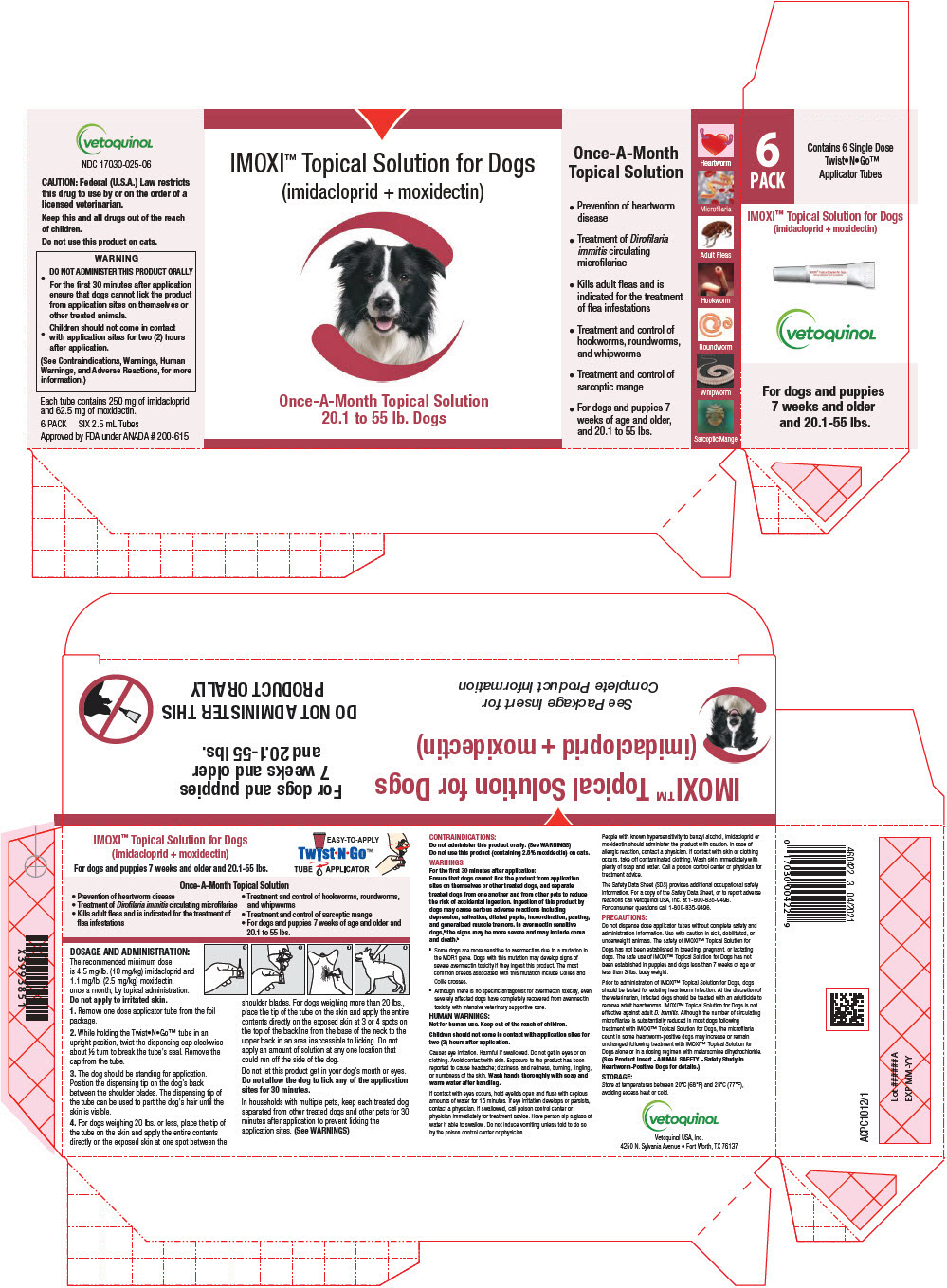
PRINCIPAL DISPLAY PANEL - 2.5 mL Tube Blister Pack Carton - imoxi 07
-
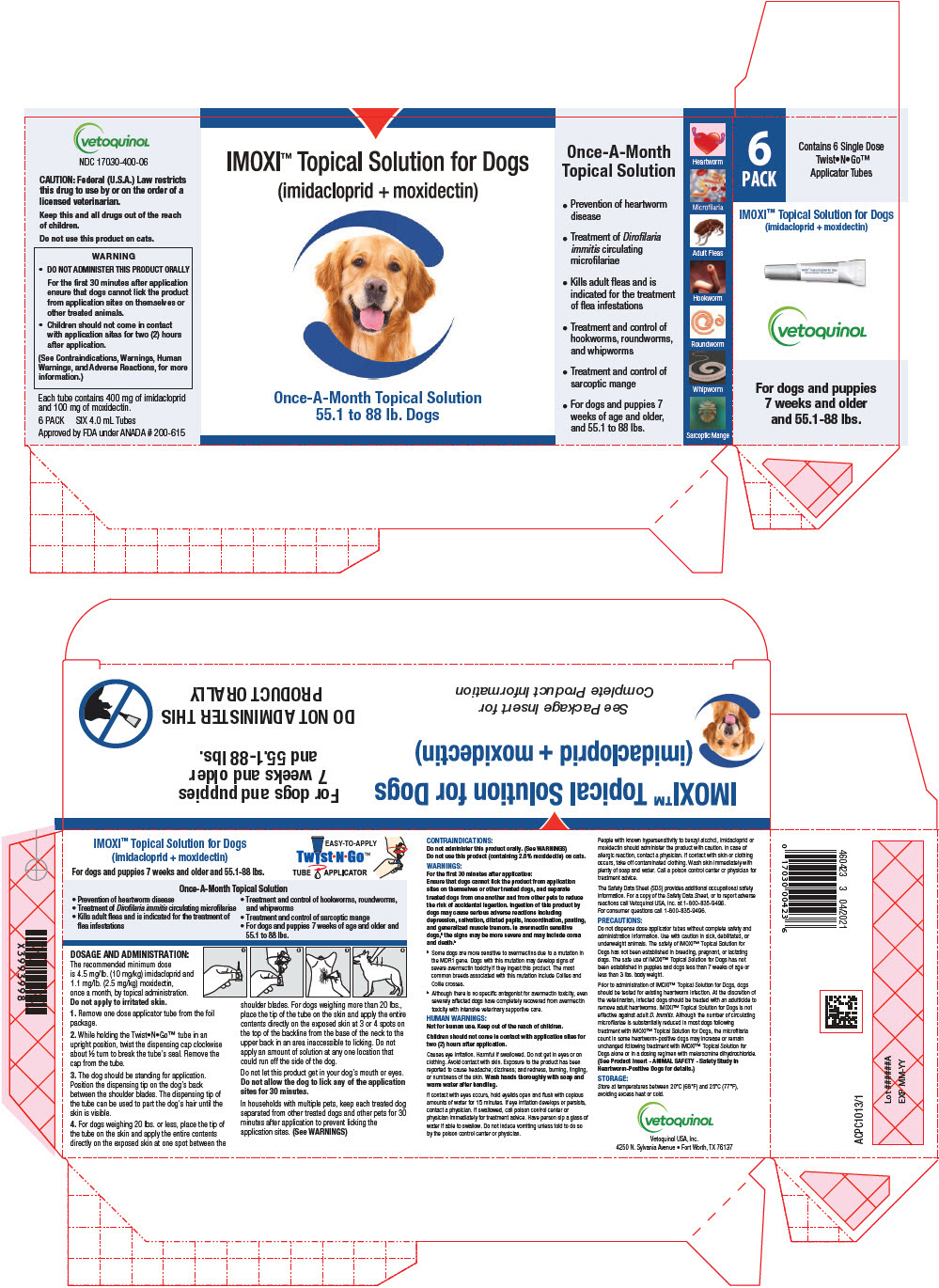
PRINCIPAL DISPLAY PANEL - 4.0 mL Tube Blister Pack Carton - imoxi 08
-
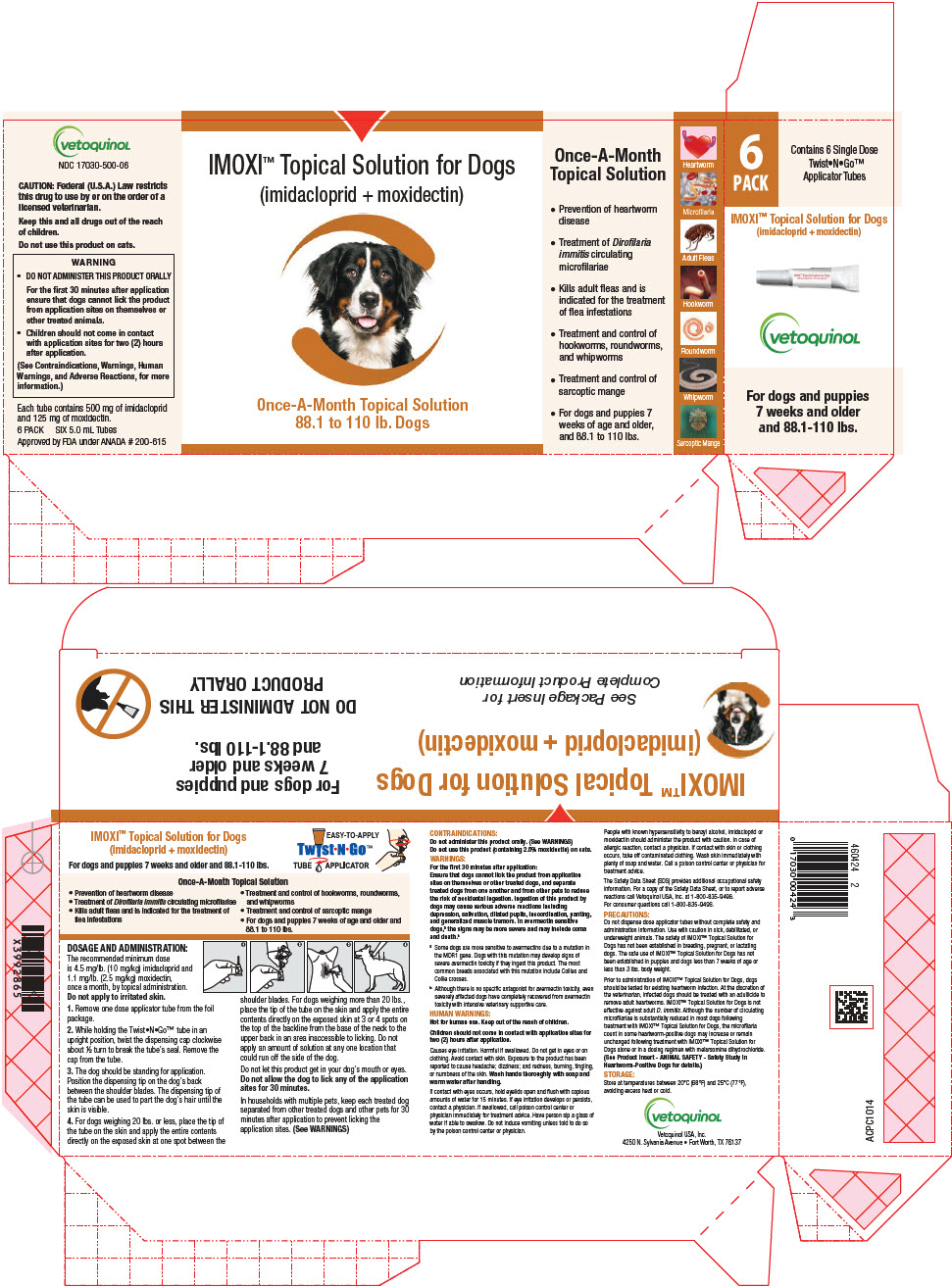
PRINCIPAL DISPLAY PANEL - 5.0 mL Tube Blister Pack Carton - imoxi 09
Imoxi For Dogs Animal Product Labeling Information
The product labeling information includes all published material associated to a drug. Product labeling documents include information like generic names, active ingredients, ingredient strength dosage, routes of administration, appearance, usage, warnings, inactive ingredients, etc.
Table of Contents
- Veterinary Indications
- Warning
- Caution:
- Description:
- Indications:
- Contraindications:
- Warnings:
- Human Warnings:
- Precautions:
- Other
- Dosage And Administration:
- Storage Information:
- How Supplied:
- Principal Display Panel - 0.4 Ml Tube Blister Pack Carton
- Principal Display Panel - 1.0 Ml Tube Blister Pack Carton
- Principal Display Panel - 2.5 Ml Tube Blister Pack Carton
- Principal Display Panel - 4.0 Ml Tube Blister Pack Carton
- Principal Display Panel - 5.0 Ml Tube Blister Pack Carton
Veterinary Indications
ACPX1008
Once-a-month topical solution for the prevention of heartworm disease, the treatment of circulating microfilariae, kills adult fleas, is indicated for the treatment of flea infestations, the treatment and control of sarcoptic mange, as well as the treatment and control of intestinal parasite infections in dogs and puppies that are at least 7 weeks of age and that weigh at least 3 lbs.
Warning
- DO NOT ADMINISTER THIS PRODUCT ORALLY
- For the first 30 minutes after application ensure that dogs cannot lick the product from application sites on themselves or other treated animals.
- Children should not come in contact with application sites for two (2) hours after application.
(See Contraindications, Warnings, Human Warnings, and Adverse Reactions, for more information.)
Caution:
Federal (USA) Law restricts this drug to use by or on the order of a licensed veterinarian.
Description:
IMOXI™ Topical Solution for Dogs (10% imidacloprid + 2.5% moxidectin) is a colorless to yellow ready-to-use solution packaged in single dose applicator tubes for topical treatment of dogs. The formulation and dosage schedule are designed to provide a minimum of 4.5 mg/lb. (10 mg/kg) imidacloprid and 1.1 mg/lb. (2.5 mg/kg) moxidectin based on body weight.
Imidacloprid is a chloronicotinyl nitroguanidine insecticide. The chemical name for imidacloprid is 1- [(6-Chloro- 3-pyridinyl) methyl]-N-nitro-2-imidazolidinimine. Moxidectin is a semisynthetic macrocyclic lactone endectocide derived from the actinomycete Streptomycetes cyaneogriseus noncyanogenus. The chemical name for moxidectin is [6R, 23E, 25S(E)]-5-O-Demethyl-28-deoxy- 25-(1,3-dimethl-1- butenyl)-6,28-epoxy-23-(methoxyimino) milbemycin B.
Indications:
IMOXI™ Topical Solution for Dogs is indicated for the prevention of heartworm disease caused by Dirofilaria immitis and the treatment of Dirofilaria immitis circulating microfilariae in heartworm-positive dogs. IMOXI™ Topical Solution for Dogs kills adult fleas and is indicated for the treatment of flea infestations (Ctenocephalides felis). IMOXI™ Topical Solution for Dogs is indicated for the treatment and control of sarcoptic mange caused by Sarcoptes scabiei var. canis. IMOXI™ Topical Solution for Dogs is also indicated for the treatment and control of the following intestinal parasites:
| Intestinal Parasite | Intestinal Stage | |||
|---|---|---|---|---|
| Adult | Immature Adult | Fourth Stage Larvae | ||
| Hookworm Species | Ancylostoma caninum | X | X | X |
| Uncinaria stenocephala | X | X | X | |
| Roundworm Species | Toxocara canis | X | X | |
| Toxascaris leonina | X | |||
| Whipworm | Trichuris vulpis | X | ||
Contraindications:
Do not administer this product orally. (See WARNINGS)
Do not use this product (containing 2.5% moxidectin) on cats.
Warnings:
For the first 30 minutes after application:
Ensure that dogs cannot lick the product from application sites on themselves or other treated dogs, and separate treated dogs from one another and from other pets to reduce the risk of accidental ingestion.
Ingestion of this product by dogs may cause serious adverse reactions including depression, salivation, dilated pupils, incoordination, panting, and generalized muscle tremors.
In avermectin sensitive dogs, Some dogs are more sensitive to avermectins due to a mutation in the MDR1 gene. Dogs with this mutation may develop signs of severe avermectin toxicity if they ingest this product. The most common breeds associated with this mutation include Collies and Collie crosses. Although there is no specific antagonist for avermectin toxicity, even severely affected dogs have completely recovered from avermectin toxicity with intensive veterinary supportive care.
Human Warnings:
Not for human use. Keep out of the reach of children. Children should not come in contact with application sites for two (2) hours after application.
Causes eye irritation. Harmful if swallowed. Do not get in eyes or on clothing. Avoid contact with skin. Exposure to the product has been reported to cause headache; dizziness; and redness, burning, tingling, or numbness of the skin.
Wash hands thoroughly with soap and warm water after handling.
If contact with eyes occurs, hold eyelids open and flush with copious amounts of water for 15 minutes. If eye irritation develops or persists, contact a physician. If swallowed, call poison control center or physician immediately for treatment advice. Have person sip a glass of water if able to swallow. Do not induce vomiting unless told to do so by the poison control center or physician. People with known hypersensitivity to benzyl alcohol, imidacloprid or moxidectin should administer the product with caution. In case of allergic reaction, contact a physician. If contact with skin or clothing occurs, take off contaminated clothing. Wash skin immediately with plenty of soap and water. Call a poison control center or physician for treatment advice.
The Safety Data Sheet (SDS) provides additional occupational safety information. For consumer questions call 1-800-835-9496.
For a copy of the Safety Data Sheet (SDS) or to report adverse reactions call Vetoquinol USA, Inc. at 1-800-835-9496.
Precautions:
Do not dispense dose applicator tubes without complete safety and administration information.
Use with caution in sick, debilitated, or underweight animals. The safety of IMOXI™ Topical Solution for Dogs has not been established in breeding, pregnant, or lactating dogs. The safe use of IMOXI™ Topical Solution for Dogs has not been established in puppies and dogs less than 7 weeks of age or less than 3 lbs. body weight. Prior to administration of IMOXI™ Topical Solution for Dogs, dogs should be tested for existing heartworm infection. At the discretion of the veterinarian, infected dogs should be treated with an adulticide to remove adult heartworms. The safety of IMOXI™ Topical Solution for Dogs has not been evaluated when administered on the same day as an adulticide. IMOXI™ Topical Solution for Dogs is not effective against adult D. immitis. Although the number of circulating microfilariae is substantially reduced in most dogs following treatment with IMOXI™ Topical Solution for Dogs, the microfilaria count in some heartworm-positive dogs may increase or remain unchanged following treatment with IMOXI™ Topical Solution for Dogs, alone or in a dosing regimen with melarsomine dihydrochloride.
(See ADVERSE REACTIONS and ANIMAL SAFETY – Safety Study in Heartworm-Positive Dogs.)
IMOXI™ Topical Solution for Dogs has not been evaluated in heartworm-positive dogs with Class 4 heartworm disease.
Other
Heartworm-Negative Dogs
Field Studies: Following treatment with imidacloprid and moxidectin topical solution or an active control, dog owners reported the following post-treatment reactions:
| OBSERVATION | imidacloprid and moxidectin topical solution n=128 | Active Control n=68 |
|---|---|---|
| Pruritus | 19 dogs (14.8%) | 7 dogs (10.3%) |
| Residue | 9 dogs (7.0%) | 5 dogs (7.4%) |
| Medicinal Odor | 5 dogs (3.9%) | None observed |
| Lethargy | 1 dog (0.8%) | 1 dog (1.5%) |
| Inappetence | 1 dog (0.8%) | 1 dog (1.5%) |
| Hyperactivity | 1 dog (0.8%) | None observed |
During a field study using 61 dogs with pre-existing flea allergy dermatitis, one (1.6 %) dog experienced localized pruritus immediately after imidacloprid application, and one investigator noted hyperkeratosis at the application site of one dog (1.6 %).
In a field safety and effectiveness study, imidacloprid and moxidectin topical solution was administered to 92 client-owned dogs with sarcoptic mange. The dogs ranged in age from 2 months to 12.5 years and ranged in weight from 3 to 231.5 pounds. Adverse reactions in dogs treated with imidacloprid and moxidectin topical solution included hematochezia, diarrhea, vomiting, lethargy, inappetence, and pyoderma.
Laboratory Effectiveness Studies: One dog in a laboratory effectiveness study experienced weakness, depression, and unsteadiness between 6 and 9 days after application with imidacloprid and moxidectin topical solution. The signs resolved without intervention by day 10 post-application. The signs in this dog may have been related to peak serum levels of moxidectin, which vary between dogs, and occur between 1 and 21 days after application of imidacloprid and moxidectin topical solution.
The following clinical observations also occurred in laboratory effectiveness studies following application with imidacloprid and moxidectin topical solution and may be directly attributed to the drug or may be secondary to the intestinal parasite burden or other underlying conditions in the dogs: diarrhea, bloody stools, vomiting, anorexia, lethargy, coughing, ocular discharge and nasal discharge. Observations at the application sites included damp, stiff or greasy hair, the appearance of a white deposit on the hair, and mild erythema, which resolved without treatment within 2 to 48 hours.
Heartworm-Positive Dogs
Field Study: A 56-day field safety study was conducted in 214 D. immitis heartworm and microfilaria positive dogs with Class 1, 2 or 3 heartworm disease. All dogs received imidacloprid and moxidectin topical solution on Study Days 0 and 28; 108 dogs also received melarsomine dihydrochloride on Study Days – 14, 14, and 15. All dogs were hospitalized for a minimum of 12 hours following each treatment. Effectiveness against circulating D. immitis microfilariae was > 90 % at five of six sites; however, one site had an effectiveness of 73.3 %. The microfilaria count in some heartworm-positive dogs increased or remained unchanged following treatment with imidacloprid and moxidectin topical solution alone or in a dosing regimen with melarsomine dihydrochloride.
Following treatment with imidacloprid and moxidectin topical solution alone or in a dosing regimen with melarsomine dihydrochloride, the following adverse reactions were observed:
| Adverse Reaction | Dogs Treated with imidacloprid and moxidectin topical solution n=106 | Dogs Treated with imidacloprid and moxidectin topical solution + Melarsomine n=108 |
|---|---|---|
| Cough | 24 (22.6%) | 25 (23.1%) |
| Lethargy | 14 (13.2%) | 42 (38.9%) |
| Vomiting | 11 (10.4%) | 18 (16.7%) |
| Diarrhea, including hemorrhagic | 10 (9.4%) | 22 (20.4%) |
| Inappetence | 7 (6.6%) | 19 (17.6%) |
| Dyspnea | 6 (5.7%) | 10 (9.3%) |
| Tachypnea | 1 (<1%) | 7 (6.5%) |
| Pulmonary Hemorrhage | 0 | 1 (<1%) |
| Death | 0 | 3 (2.8%) |
Three dogs treated with imidacloprid and moxidectin topical solution in a dosing regimen with melarsomine dihydrochloride died of pulmonary embolism from dead and dying heartworms. One dog, treated with imidacloprid and moxidectin topical solution and melarsomine dihydrochloride, experienced pulmonary hemorrhage and responded to supportive medical treatment. Following the first treatment with imidacloprid and moxidectin topical solution alone, two dogs experienced adverse reactions (coughing, vomiting, and dyspnea) that required hospitalization. In both groups, there were more adverse reactions to imidacloprid and moxidectin topical solution following the first treatment than the second treatment.
To report a suspected adverse reaction, call 1-800-835-9496.
Post-Approval Experience:
The following adverse events are based on postapproval adverse drug experience reporting. Not all adverse reactions are reported to FDA CVM. It is not always possible to reliably estimate the adverse event frequency or establish a causal relationship to product exposure using this data. The following adverse events in dogs are listed in decreasing order of reporting frequency: depression/lethargy, vomiting, pruritus, diarrhea, anorexia, hyperactivity, ataxia, trembling, hypersalivation, application site reactions (alopecia, pruritus, lesions, and erythema), seizures, and anaphylaxis/anaphylactic reactions (hives, urticaria, facial swelling, edema of the head).
Serious reactions, including neurologic signs and death have been reported when cats have been exposed (orally and topically) to this product.
In humans, nausea, numbness or tingling of the mouth/lips and throat, ocular and dermal irritation, pruritus, headache, vomiting, diarrhea, depression and dyspnea have been reported following exposure to this product.
To report suspected adverse drug events, for technical assistance or to obtain a copy of the SDS, contact Vetoquinol USA, Inc. at 1-800-835-9496.
For additional information about adverse drug experience reporting for animal drugs, contact FDA at 1-888-FDA-VETS or online at http://www.fda.gov/ reportanimalae.
Heartworm Prevention: For prevention of heartworm disease, IMOXI™ Topical Solution for Dogs should be administered at one-month intervals. IMOXI™ Topical Solution for Dogs may be administered year-round or at a minimum should start one month before the first expected exposure to mosquitoes and should continue at monthly intervals until one month after the last exposure to mosquitoes. If a dose is missed and a 30-day interval between doses is exceeded, administer IMOXI™ Topical Solution for Dogs immediately and resume the monthly dosing schedule. When replacing another heartworm preventative product in a heartworm prevention program, the first treatment with IMOXI™ Topical Solution for Dogs should be given within one month of the last dose of the former medication.
Treatment of Circulating Microfilaria: For the treatment of circulating D. immitis microfilaria in heartworm-positive dogs, IMOXI™ Topical Solution for Dogs should be administered at one-month intervals. Treatment with an approved adulticide therapy is recommended because IMOXI™ Topical Solution for Dogs is not effective for the treatment of adult D. immitis. (See PRECAUTIONS)
Flea Treatment: For the treatment of flea infestations, IMOXI™ Topical Solution for Dogs should be administered at one-month intervals. If the dog is already infested with fleas when the first dose of IMOXI™ Topical Solution for Dogs is administered, adult fleas on the dog will be killed. However, reinfestation from the emergence of preexisting pupae in the environment may continue to occur for six weeks or longer after treatment is initiated. Dogs treated with imidacloprid, including those with pre-existing flea allergy dermatitis have shown clinical improvement as a direct result of elimination of fleas from the dog.
Treatment and Control of Intestinal Nematode Infections: For the treatment and control of intestinal hookworm infections caused by Ancylostoma caninum and Uncinaria stenocephala (adults, immature adults and fourth stage larvae) and roundworm infections caused by Toxocara canis (adults and fourth stage larvae), and Toxascaris leonina (adults), and whipworm infections caused by Trichuris vulpis (adults), IMOXI™ Topical Solution for Dogs should be administered once as a single topical dose.
Treatment and Control of Sarcoptic Mange: For the treatment and control of sarcoptic mange caused by Sarcoptes scabiei var. canis, IMOXI™ Topical Solution for Dogs should be administered as a single topical dose. A second monthly dose may be administered if necessary.
Heartworm–Negative Dogs
Field Study: In a controlled, double-masked, field safety study, imidacloprid and moxidectin topical solution was administered to 128 dogs of various breeds, 3 months to 15 years of age, weighing 4 to 157 pounds. Imidacloprid and moxidectin topical solution was used safely in dogs concomitantly receiving ACE inhibitors, anticonvulsants, antihistamines, antimicrobials, chondroprotectants, corticosteroids, imrnunotherapeutics, MAO inhibitors, NSAIDs, ophthalmic medications, sympathomimetics, synthetic estrogens, thyroid hormones, and urinary acidifiers. Owners reported the following signs in their dogs after application of imidacloprid and moxidectin topical solution: pruritus, flaky/greasy residue at the treatment site, medicinal odor, lethargy, inappetence, and hyperactivity.
(See ADVERSE REACTIONS)
Safety Study in Puppies: Imidacloprid and moxidectin topical solution was applied topically at 1, 3 and 5X the recommended dose to 7-week-old Beagle puppies once every 2 weeks for 6 treatments on days 0, 14, 28, 42, 56, and 70. Loose stools and diarrhea were observed in all groups, including the controls, throughout the study. Vomiting was seen in one puppy from the 1X treatment group (day 57), in two puppies from the 3X treatment group (days 1 and 79), and in one puppy from the 5X treatment group (day 1). Two puppies each in the 1X, 3X, and 5X groups had decreased appetites within 24 hours post-dosing. One puppy in the 1X treatment group had pruritus for one hour following the fifth treatment. A puppy from the 5X treatment group displayed rapid, difficult breathing from 4 to 8 hours following the second treatment.
Dermal Dose Tolerance Study: Imidacloprid and moxidectin topical solution was administered topically to 8-month-old Beagle dogs at 10X the recommended dose once. One dog showed signs of treatment site irritation after application. Two dogs vomited, one at 6 hours and one at 6 days post-treatment. Increased RBC, hemoglobin, activated partial thromboplastin, and direct bilirubin were observed in the treated group. Dogs in the treated group did not gain as much weight as the control group.
Oral Safety Study in Beagles: Imidacloprid and moxidectin topical solution was administered once orally at the recommended topical dose to 12 dogs. Six dogs vomited within 1 hour of receiving the test article, 2 of these dogs vomited again at 2 hours, and 1 dog vomited again up to 18 hours post-dosing. One dog exhibited shaking (nervousness) 1 hour post-dosing. Another dog exhibited abnormal neurological signs (circling, ataxia, generalized muscle tremors, and dilated pupils with a slow pupillary light response) starting at 4 hours post-dosing through 18 hours post-dosing. Without treatment, this dog was neurologically normal at 24 hours and had a normal appetite by 48 hours post-dosing.
(See CONTRAINDICATIONS)
Dermal Safety Study in Ivermectin-Sensitive Collies: Imidacloprid and moxidectin topical solution was administered topically at 3 and 5X the recommended dose every 28 days for 3 treatments to Collies which had been prescreened for avermectin sensitivity. No clinical abnormalities were observed.
Oral Safety Study in Ivermectin-Sensitive Collies: Imidacloprid and moxidectin topical solution was administered orally to 5 pre-screened ivermectin-sensitive Collies. The Collies were asymptomatic after ingesting 10% of the minimum labeled dose. At 40% of the minimum recommended topical dose, 4 of the dogs experienced neurological signs indicative of avermectin toxicity including depression, ataxia, mydriasis, salivation, muscle fasciculation, and coma, and were euthanized.
(See CONTRAINDICATIONS)
Heartworm-Positive Dogs
Laboratory Safety Study in Heartworm-Positive Dogs: Imidacloprid and moxidectin topical solution was administered topically at 1 and 5X the recommended dose every 14 days for 3 treatments to dogs with adult heartworm infections and circulating microfilaria. At 5X, one dog was observed vomiting three hours after the second treatment. Hypersensitivity reactions were not seen in the 5X treatment group. Microfilaria counts decreased with treatment.
Approved by FDA under ANADA # 200-615
Made in U.S.A. © 2019 Vetoquinol USA, Inc.
Vetoquinol, the Vetoquinol logo, and
IMOXI™ Topical Solution for Dogs are registered
trademarks of Vetoquinol USA, Inc.
Vetoquinol USA, Inc.
4250 N. Sylvania Avenue
Fort Worth, TX 76137
R1 - 05/2020
Dosage And Administration:
The recommended minimum dose is 4.5 mg/lb. (10 mg/kg) imidacloprid and 1.1 mg/lb. (2.5 mg/kg) moxidectin, once a month, by topical administration.
Do not apply to irritated skin.
1. Remove one dose applicator tube from the package. As specified in the table, administer the entire contents of the IMOXI™ Topical Solution for Dogs tube that correctly corresponds with the body weight of the dog.
| Dog (lbs.) | Volume (mL) | Imidacloprid (mg) | Moxidectin (mg) |
|---|---|---|---|
| 3–9 | 0.4 | 40 | 10 |
| 9.1–20 | 1.0 | 100 | 25 |
| 20.1–55 | 2.5 | 250 | 62.5 |
| 55.1–88 | 4.0 | 400 | 100 |
| 88.1–110 Dogs over 110 lbs. should be treated with the appropriate combination of IMOXI™ Topical Solution for Dogs tubes. | 5.0 | 500 | 125 |
2. While holding the Twist•N•Go™ tube in an upright position, twist the dispensing cap clockwise about ½ turn to break the tube's seal. Remove the cap from the tube.
3. The dog should be standing for application. Position the dispensing tip on the dog's back between the shoulder blades. The dispensing tip of the tube can be used to part the dog's hair until the skin is visible.
4. For dogs weighing 20 lbs. or less, place the tip of the tube on the skin and apply the entire contents directly on the exposed skin at one spot between the shoulder blades. For dogs weighing more than 20 lbs., place the tip of the tube on the skin and apply the entire contents directly on the exposed skin at 3 or 4 spots on the top of the backline from the base of the neck to the upper back in an area inaccessible to licking. Do not apply an amount of solution at any one location that could run off the side of the dog.
Do not let this product get in your dog's mouth or eyes. Do not allow the dog to lick any of the application sites for 30 minutes. In households with multiple pets, keep each treated dog separated from other treated dogs and other pets for 30 minutes after application to prevent licking the application sites. (See WARNINGS)
Stiff hair, a damp appearance of the hair, pink skin, or a slight powdery residue may be observed at the application site on some animals. This is temporary and does not affect the safety and effectiveness of the product.
Shampooing 90 minutes after treatment does not reduce the effectiveness of IMOXI™ Topical Solution for Dogs in the prevention of heartworm disease. Shampooing or water immersion 4 days after treatment will not reduce the effectiveness of IMOXI™ Topical Solution for Dogs in the treatment of flea infestations. However, shampooing as often as once weekly may reduce the effectiveness of the product against fleas.
Storage Information:
Store at temperatures between 20° C (68 °F) and 25° C (77 °F), avoiding excess heat or cold.
How Supplied:
| Applications Per Package: | 6 × 0.4 mL tubes 6 × 1.0 mL tubes 6 × 2.5 mL tubes | 6 × 4.0 mL tubes 6 × 5.0 mL tubes |
Principal Display Panel - 0.4 Ml Tube Blister Pack Carton
IMOXI™ Topical Solution for Dogs
(imidacloprid + moxidectin)
Once-A-Month Topical Solution
3 to 9 lb. Dogs
Principal Display Panel - 1.0 Ml Tube Blister Pack Carton
IMOXI™ Topical Solution for Dogs
(imidacloprid + moxidectin)
Once-A-Month Topical Solution
9.1 to 20 lb. Dogs
Principal Display Panel - 2.5 Ml Tube Blister Pack Carton
IMOXI™ Topical Solution for Dogs
(imidacloprid + moxidectin)
Once-A-Month Topical Solution
20.1 to 55 lb. Dogs
Principal Display Panel - 4.0 Ml Tube Blister Pack Carton
IMOXI™ Topical Solution for Dogs
(imidacloprid + moxidectin)
Once-A-Month Topical Solution
55.1 to 88 lb. Dogs
Principal Display Panel - 5.0 Ml Tube Blister Pack Carton
IMOXI™ Topical Solution for Dogs
(imidacloprid + moxidectin)
Once-A-Month Topical Solution
88.1 to 110 lb. Dogs
* The information on this page is for an ANIMAL PRODUCT, please review the complete disclaimer below.